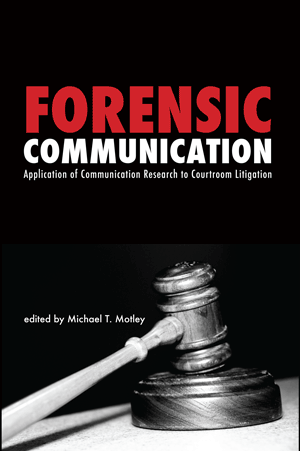Forensic Communication: Application of Communication Research to Courtroom Litigation | |
|  | Quantity in Basket:none
Code: 978-1-61289-080-7
Price:$79.50
Title: Forensic Communication
Sub-title: Application of Communication Research to Courtroom Litigation
Editor(s): Michael T. Motley
Publish Date: June 2012
Pages: 348
Format: Cloth
| |
| Virtually every science discipline has a recognized forensics sub-area. Until now, however, forensic communication has not been introduced as a viable area of study or practice. In this volume, recognized scholars discuss ways they have applied communication research to court cases as an expert-witness or consultant in such areas as jury selection, pretrial publicity, sexual consent, warning adequacy, hindsight bias, jury decision making, document authorship identification, graphics and simulations, and several others.
For attorneys, the volume may provide an introduction to ways that communication scholarship can inform their future cases. For communication scholars--both established and upcoming--it may suggest ways to offer expertise as an expert witness or consultant. For casual and serious students of communication it will provide a look into one of the most fascinating applications of our scholarship.
Contents: Introduction. Michael T. Motley. SECTION I: COMMUNICATION APPLICATIONS/COURT CONSULTATION. BEFORE THE TRIAL. Musical Chairs in the Jury Box: Trial Consulting and Jury Selection, Mark A. de Turck. Factors Influencing Jury Decision Making: Before the Trial Starts, Ann Burnett. Pretrial Publicity: Influences of Media Content and Stylistic Characteristics, Nadia Lepastourel and Benoît Testé. Deception and Deception Detection. Timothy R. Levine. DURING THE TRIAL. Factors Influencing Jury Decision Making: Prior to and During Deliberations, Ann Burnett. Hindsight Bias, Juror Decision Making, and Courtroom Communication, Debra L. Worthington and Merrie Jo Pitera. Integrating Victims' Voices in the U.S. Criminal Justice System, Susan J. Szmania and Dan Mangis. Pursuing Justice for Unwanted Pursuit: Stalking Research in the Courtroom, Charles W. Kim, Jr. and Brian H. Spitzberg. Visual Forensics: Optimizing Graphics in the Courtroom, Shannon Dyer. SECTION II: COMMUNICATION APPLICATIONS: EXPERT WITNESS TESTIMONY. CONTENT. Effects of Sexually Oriented Messages on Individuals and Communities: A History of Challenging Assumptions in the Courtroom, Daniel Linz. Semantics in Court: Providing Opinions on Likely Meanings of Messages, Michael T. Motley. Forensic Linguistics, Gerald R. McMenamin. Forensic Technology: Computers and Digital Media as Sources of Evidence, Raymond Hsieh and Patricia E. Paola. PRESENTATION. Effects of Direct Non-Physical Evidence on Trials: Confessions and Eyewitness Testimony, Franklin J. Boster. Testing Expert Opinion via Standard Empirical Methods, Michael T. Motley. Friendly Advice for the Expert Witness in Communication, Michael T. Motley. About the Editor. About the Authors. Author Index. Subject Index.
|
| |







